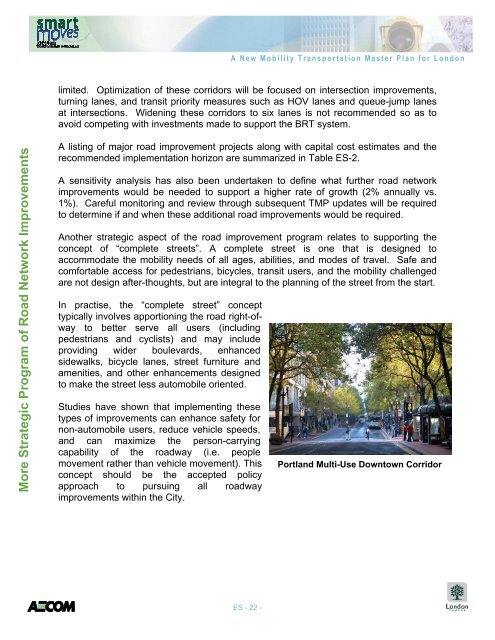A New Mobility Transportation Master Plan for London
A New Mobility Transportation Master Plan for London
A New Mobility Transportation Master Plan for London
You also want an ePaper? Increase the reach of your titles
YUMPU automatically turns print PDFs into web optimized ePapers that Google loves.
More Strategic Program of Road Network Improvements<br />
A <strong>New</strong> <strong>Mobility</strong> <strong>Transportation</strong> <strong>Master</strong> <strong>Plan</strong> <strong>for</strong> <strong>London</strong><br />
limited. Optimization of these corridors will be focused on intersection improvements,<br />
turning lanes, and transit priority measures such as HOV lanes and queue-jump lanes<br />
at intersections. Widening these corridors to six lanes is not recommended so as to<br />
avoid competing with investments made to support the BRT system.<br />
A listing of major road improvement projects along with capital cost estimates and the<br />
recommended implementation horizon are summarized in Table ES-2.<br />
A sensitivity analysis has also been undertaken to define what further road network<br />
improvements would be needed to support a higher rate of growth (2% annually vs.<br />
1%). Careful monitoring and review through subsequent TMP updates will be required<br />
to determine if and when these additional road improvements would be required.<br />
Another strategic aspect of the road improvement program relates to supporting the<br />
concept of “complete streets”. A complete street is one that is designed to<br />
accommodate the mobility needs of all ages, abilities, and modes of travel. Safe and<br />
com<strong>for</strong>table access <strong>for</strong> pedestrians, bicycles, transit users, and the mobility challenged<br />
are not design after-thoughts, but are integral to the planning of the street from the start.<br />
In practise, the “complete street” concept<br />
typically involves apportioning the road right-ofway<br />
to better serve all users (including<br />
pedestrians and cyclists) and may include<br />
providing wider boulevards, enhanced<br />
sidewalks, bicycle lanes, street furniture and<br />
amenities, and other enhancements designed<br />
to make the street less automobile oriented.<br />
Studies have shown that implementing these<br />
types of improvements can enhance safety <strong>for</strong><br />
non-automobile users, reduce vehicle speeds,<br />
and can maximize the person-carrying<br />
capability of the roadway (i.e. people<br />
movement rather than vehicle movement). This<br />
concept should be the accepted policy<br />
approach to pursuing all roadway<br />
improvements within the City.<br />
ES - 22 -<br />
Portland Multi-Use Downtown Corridor


